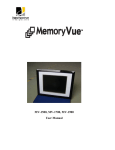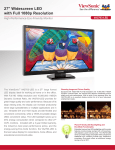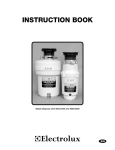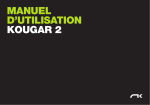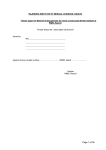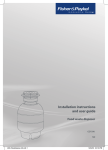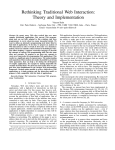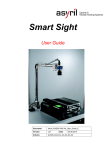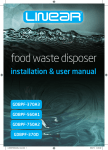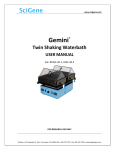Download Frigidaire FFDI331CMS Owner's Guide
Transcript
All about the Use & Care of your Food Waste Disposer TA B L E O F C O N T E N T S Operating Instructions ........................................ 7 Important Safety Instructions .............................. 2 Troubleshooting ................................................. 8 Removal of Old Unit ........................................... 3 Cleaning and Maintenance .................................. 8 Installation of Mounting Assembly ................... 4 - 5 Notes ............................................................... 9 Electrical Connections ........................................ 6 Warranty ........................................................ 10 www.frigidaire.com USA 1-800-944-9044 www.frigidaire.ca Canada 1-800-265-8352 560C525P02 RevB (September 2011) Product Registration ........................................... 2 PRODUCT REGISTRATION Bill of sale, sales slip, cancelled check or other purchase record should be kept to verify the original purchase date for warranty purposes. Model Number* See insert for specific information about your new disposer: NOTE: This Food Waste Disposer has been designed to operate on 110-120 Volt, 60Hz exclusively. Using any other voltage or Hz adversely affects performance. IMPORTANT: Read all instructions thoroughly. Keep this guide for future reference. Serial Number* *Above information appears on the label affixed to bottom of the disposer. For your convenience, write down the model and serial numbers prior to installation. CAUTION: Be sure to review SAFETY INSTRUCTIONS FIRST PERTAINING TO A RISK OF FIRE, ELECTRICAL SHOCK OR INJURY TO PERSONS before using disposer. Call our toll free Help Line with any questions: 800-944-9044 IMPORTANT SAFETY INSTRUCTIONS INSTRUCTIONS PERTAINING TO A RISK OF FIRE, ELECTRIC SHOCK OR INJURY TO PERSONS. SAVE THESE INSTRUCTIONS. Note: if you are not familiar iwth electrical power and procedures, call a qualified electrician. Warning: Improper connection of the equipment-grounding conductor can result in a risk of electric shock. Check with a qualified electrician or serviceman if you are in doubt as to whether the appliance is properly grounded. Do not modify the plug provided with the appliance if it will not fit the outlet, have a proper outlet installed by a qualified electrician. Warning: 1. 2. 3. 4. 5. 6. 2 When using electrical appliances, basic precaustions should always be followed, including the following: Read all instructions before using the appliance. To reduce the risk of injury, close supervision is neces sary when an appliance is used near children. Do not put fingers or hands into a waste disposer. Turn the power switch to the off position before at tempting to clear a jam or remove an object from the disposer. When attempting to loosen a jam in a waste disposer, use a long wooden object such as a wooden spoon or the wooden handle of a broom or mop. When attempting to remove objects from a waste disposer use long-handled tongs or pliers. If the dis poser is magnetically actuated, non-magnetic tools should be used. ©2009 Electrolux Home Products, Inc. 7. To reduce the risk of injury by materials that may be expelled by a waste disposer, do not put the following into a disposer: clam or oyster shells; caustic drain cleaners or similar products; glass, china or plastic; large whole bones; metal, such as bottle caps, tin cans, aluminum foil or utensils; hot grease or other hot liquids; whole cornhusks. 8. When not operating a disposer, leave the stopper in place to reduce the risks of objects falling onto the disposer. 9. DO NOT operate disposer unless splash guard is in place. (Does not apply to the Top Control/Batch Feed units.) 10. For proper grounding instructions see the ELECTRICAL CONNECTION portion of this manual. All rights reserved. Printed in the USA REMOVAL OF OLD UNIT TYPICAL INSTRUCTIONS, YOUR MODEL MAY VARY Before starting this step, turn off electrical power at the circuit breaker or fuse box. If your old mount is the same as the mount on your new disposer, just reverse the assembly instructions found in section Installation of Mounting Assembly. If your new mount system is different, follow these instructions: A. Use a pipe wrench to disconnect drain line where it attaches to disposer discharge tube (see A). B. Remove disposer from sink flange by turning mount ring to the left clockwise (see B). If you are unable to turn the mount ring, tap on one of the extensions from the ring with a hammer. Some mounting systems have tubular extensions. Inserting a screwdiver into on tube will provide additional leverage for turning the mount ring (see B). Some disposers may require the removal or loosening of nuts from the mount screws (see C). Some disposers may require the removal of a clamp. IMPORTANT: Unless you have a new home, this is a good time to clean out the trap and drain lines by running a drain auger or plumber’s snake before installing your new disposer. Caution: Be sure to support the disposer while perfomring this step or it may fall when the mounting ring is disconnected from the mounting assembly. If your disposer is hard wired (metal shielded cable not utilizing a wall plug), complete steps C and D. If you utilize a plug- in cord, go on to step E. C. When disposer is removed, turn up side down and remove electrical cover plate (see D). D. Use screwdriver to remove green ground wire. Remove wire nuts from black and white power wires and separate disposer wires from power cable wires. Loosen screws on cable clamp and separate cable from disposer. E. To remove remaining mount system from the sink, loosen mount screws, push mount ring up. Under it is the snap ring. Use screwdriver to pop off ring (see E). Remove mount ring, protector ring and gasket from sink flange. Some mounts will require the unscrewing of a large ring holding the sink flange in place. Pull sink flange up through sink and clean off old putty from sink. DISHWASHER CONNECTION If you are utilizing a dishwasher, complete the following procedure. If dishwasher is not to be connected go to section Installation of Mounting Assembly. A. Using a blunt instrument (steel punch or wooden dowl), knock out entire plug (see A). Do no use a screwdriver or sharp instrument. When knockout plug falls into disposer, ou may remove it or simply grind it up when the disposer is used. This will not damage the disposer in any way, but may take sometime to grind, over the course of several uses. Go to section Installation of Mounting Assembly. B. Connect dishwasher hose using hose clamp. If hose size is different, you will need a Dishwasher Connector Kit (see B). Make sure all plumbing connections are tight and in accordance with all plumbing codes and ordinan ces. Run water and check for leaks. 3 INSTALLATION OF MOUNTING ASSEMBLY Mount System READ COMPLETELY BEFORE STARTING NOTE: Pay close attention to the order of mount assembly parts, as they have been correctly assembled by the factory. A. Disassemble the mounting assembly, as it has been shipped, by turning the sink flange assembly until the projections align with the notches in the lower mount ring and allow you to pull th sink flange up and out of the remaining lower mount assembly. Note the sequence of these parts as they are stacked to identigy each part. Unscrew the 3 mount screws until the mounting ring can be moved to the top of the back up flange. Remove the snap ring with a screw driver. B. Keep these assembled parts together and set aside. Before you connect the disposer to the mount assembly under the sink. Make sure the lower mounting is in place and teh hush cushion is engaged properly to the top of the hopper. C. Be sure your sink is clean. Pack the underside rim of the sink flange with plumber’s putty. Position the sink flange so it is centered and readable as you look into your sink. Push the sink opening to make a good seal. DO NOT move or rotate the sink flange once seated or the seal may be broken. D. Take the remaining portion of the mount assembly, as it was set aside and make sure that the rubber gasket is on top of the protector ring. From under the sink, while holding the sink flange firmly with on hand, line up the notches in the mount ring with the projections of the sink flange. Slide the mount assembly up onto the sink flange. Slide the mount assembly up onto the sink flange, past the projections 4 E. Tighten the 3 mounting screws evenly with a screwdriver (see E). DO NO OVERTIGHTEN! Trim off excess putty. INSTALLATION OF MOUNTING ASSEMBLY YOUR DISPOSER COMES WITH THE FOLLOWING MOUNT SYSTEM Mount System READ COMPLETELY BEFORE STARTING NOTE: Pay close attention to the order of mount assembly parts, as they have been correctly assembled by the factory. A. Evenly apply 1/2” thick rope of plumber’s putty around flange (1). B. Press Flange (1) firmly into sink drain. Remove excess putty. C. Insert fiber gasket (2), backup flange (3) and mounting ring (5). Hold in place while inserting snap ring (6). D. Place a weight such as a disposer on the sink flange to hold it in place. Use a towel to prevent scratching sink. Pull snap ring open adn press firmly unitl it snaps into place. E. Tighten the 1 2/3” screws (3) evenly and firmly against backup flange. Use shorter screws if sink is more than 3/8” thick. Grounding Instructions FOR WASTE DISPOSERS EQUIPPED WITH A GROUNDED PLUG-IN POWER CORD. FOR WASTE DISPOSERS NOT EQUIPPED WITH A GROUNDED PLUG-IN POWER CORD. This appliance must be grounded. In the event of a malfunction or breakdown, grounding provides a path of least resistance for electric current to reduce the risk of electric shock. This appliance is equipped with a cord having an equipment-grounding conductor and a grounding plug. The plug must be plugged into an appropriate outlet that is properly installed and grounded in accordance with all local codes and ordinances. This appliance must be grounded. In the event of a malfunction or breakdown, grounding provides a path of least resistance for electric current to reduce the risk of electric shock. The power cord (to be installed) must have an equipment-grounding conductor and a grounding plug. The plug must be plugged into an appropriate outlet that is properly installed and grounded in accordance with all local codes and ordiances. Disconnect electric power to disposer circuit before installation. Turn the circuit breaker to the OFF position or remove the fuse. 5 ELECTRICAL CONNECTIONS A. Connect disposer to 110-120 Volt, 60Hz AC current only. Wiring Disposer Directly to House Current B. If plug-in cord is used, use a three prong plub (see A). Ground wire should be attached to the ground screw in the bottom of the end bell (see B). This appliance must be connected to a grounded, metal permanent wiring system or an equipment grounding conductor must be run with the circuit conductors and connected to the equipment-grounding terminator or lead on the appliance. C. Use a cable clamp strain relief connector where power cord enters the disposer (see C). A. If you use BX cable: 1. Install cable connector in hole. 2. Connect white wire to white lead of disposer. 3. Connect black. 4. Connect bare ground. If BX cable is not used, provide a serpareate ground wire to nearest cold water metal pipe or other suitable ground, using the screw in the bottom of the end bell for the ground wire (see C). B. If your power supply does not include a ground wire, you must provide one unless metal cable is used. Attach a copper wire securely to disposer ground screw and attach other end of wire to a metal cold water pipe. Use only UL approved ground clamp. If plastic pipe is used in your home, a qualified electrician should install a proper ground. ATTACHING DISCHARGE ELBOW/ CONNECTING DISPOSER TO MOUNT ASSEMBLY A. Connect waste elbow to the disposer (see A), proceed to set B and C then connect bottom of the elbow by tightening the slip nut (see D). If you are connecting to a dishwasher, return to section (B) page 3. If not, make sure all plumbing connections are tight and in accordance with all plumbing codes and ordiances. Run water and check for leaks. B. Hang disposer by aligning 3 mounting tabs with slide-up ramps on mounting ring. C. Turn mounting ring until all 3 mounting tabs lock over the rides on the slide-up ramps. 6 OPERATING INSTRUCTIONS The Anti-Jam Swivell Impellers make a clicking sound as they swing into place. This indicates normal operation. A. Remove sink stopper. Turn on a medium flow of cold water. B. Turn switch to ON position; your motor is turning at full speed and ready to use. C. Scrape in food waste. Down the drain go table scraps, peelings, rinds, seeds, pits, small bones and coffee grounds. to speed up food waste disposal, cut or break up large bones, rinds and cobs. Large bones and fibrous husks require considerable grinding time and are more easily thrown away with other trash. Do not be alarmed that the disposer slows down while grinding. The disposer is actually increasing torque (grinding power) and is operating under normal conditions. D. Before turning disposer off, let water and disposer run for approximately 15 seconds after shredding stops. T This assures that all waste is thoroughly flushed through trap and drain. E. It is not recommended to use hot water while running disposer. Cold water will keep waste and fats solid so disposer can flush away particles. BATCH FEED OPERATING INSTRUCTIONS The Anti-Jam Swivel Impellers make a clicking sounds as they swing into place. This indicates normal operation. A. Remove sink stopper and turn on a medium flow of cold water. B. Scrape in food waste. Down the drain go table scraps, vegetable peelings, cobs, rinds, pits, bones and coffee grounds. (see A) C. Insert stopper to start disposer. (see B) One of the two small slots in stopper base must line up with switch plunger inside the neck of the disposer. Push down firmly to turn the disposer on. Lift stopper to shut the disposer off. D. Run disposer for 15 seconds after shredding stops. This assures that all waste is thoroughly flushed through the drain. E. To fill sink, insert stopper and align the largest slot with the switch plunger. (see C) Push down to seal sink without starting the disposer. When medium sized slot (see B) in stopper base is lined up with the switch plunger, water, can drain, but tableware, etc., cannot be accidentally dropped into disposer. TIPS FOR SUCCESSFUL OPERATION A. Be sure disposer is empty before using your dishwasher so it may drain properly. B. You may want to leave the stopper in the drain when not in use to prevent utensils and foreign objects from falling into the dispoer. C. Your disposer is ruggedly built to give you many years of trouble free service. It will handle all normal food wastes, but it will NOT grind or dispose of such items as plastic, tin cans, bottle caps, glass, china, leather, cloth, rubber, string, clam and oyster shells, aluminum foil or feathers. 7 TROUBLESHOOTING Before seeking repair or replacement, we recommend that you review the following: LOUD NOISES: (Other than those during grinding of IF TURNTABLE DOES NOT ROTATE FREELY: small bones and fruit pits): These are usually caused by accidental entry of a spoon, bottle cap or other foreign object. To correct this, turn off electrical switch and water. After disposer has stopped, remove *splash guard, remove object with long handled tongs, and replace *splash guard. Turn off disposer, then check for any foreign object lodged between the turntable and grind ring. Dislodge object by rotating table with a wooden broom handle and remove object. (see 8B) If no foreign object is present, there may be internal problems. UNIT DOES NOT START: Unplug power cord or turn LEAKS: If the unit leaks at the top, it may be due to: either the wall switch or breaker box switch to “OFF” position, depending on your model and wiring configuration. Remove stopper and/or *splash guard. Check to see if turntable will rotate freely using a wooden broom handle. If turntable rotates freely, replace *splash guard and check reset button to see if it has been tripped. Re-set button is red and located opposite discharge elbow, near the bottom (see 8A). Push button in until it clicks and remains depressed. 1. Improper seating of sink flange (gasket centering, putty or tightening). 2. Support ring not tightened properly. 3. Defective or improperly installed cushion mount. If unit leaks at the waste elbow, leak may be due to improper tightening of elbow flange screws. If re-set button has not been tripped, check for shorted or broken wire connecting to disposer. Check electrical power switch, fuse box or circuit breaker. If wiring and electrical components are intact, the unit may have internal problems that require service or replacement. *Splash guard not used on Top Control/Batch Feed unit. Call our toll free Help Line with any questions 800-944-9044 CLEANING AND MAINTENANCE DO NOT ATTEMPT TO LUBRICATE YOUR DISPOSER! The motor is permanently lubricated. The disposer is self cleaning and scours its internal parts with each use. NEVER put lye or chemical drain cleaners into the disposer, as they cause serious corrosion of metal parts. If used, resulting damage can be easily detected an all warranties are void. 8 Mineral deposits from your water can form on the stainless steel turntable, giving the appearance of rust. DO NOT BE ALARMED, the stainless steel turntables used will not corrode. NOTES 9 WARRANTY 1. Warranty: Electrolux Major Appliances (EMA) warrants this Frigidaire GrindProTM disposer, when installed in the United States, to be free from defects in workmanship and material during the warranty period. This warranty sets forth our total warranty commitment. We will not assume, nor authorize any person to assume for us, any other liability in connections with the sale of our products. 2. Length of Warranty: Model FFDI331 and FFDI501 - Two years from date of purchase; FFDI751 - Three years from date of purchase; FFDI502 - Five years from date of purchase: FGDI751 - Ten years from date of purchase; FPDI758 - Twelve years from date of purchase; Model FPDI103 Limited Lifetime warranty - Any model that fails to operate during its warranty period, will be repaired or replaced by Electrolux Major Appliances. This warranty is limited to the original purchaser. Original sales receipt required. 3. Defective Disposer: During the warranty period, a defective or inoperative disposer will be replaced by the company at no charge to you. Original sales receipt required. 4. Change of ownership of disposer: Warranty remains in force for warranty period from date of purchase of disposer by the first retail customer. Original reciept required. 5. Misuse of disposer: This warranty does not apply to any disposer which is misused, altered, improperly installed or used for anything other than normal private household use. Additional conditions are not covered by the warranty as follows: Electrical connections due to improper installation; leaks at the sink flange, dishwasher inlet or dishcharge elbow; damage by installer such as excessive torquing of screwed connections; incorrect operation such as grinding non-food waste; and jams. 6. How to receive Service: Contact the installer or return inoperative disposer to the place of purchase. They will replace your inoperative disposer with a new disposer at no charge to you. 7. Customer Service: If you do not receive satisfaction from the place of purchase, please contact our Customer Service department: Telephone: 1-800-944-9044; Website: www.frigidaire.com; Mail: Frigidaire P.O. Box 212378 Martinez, GA 30917. 10 8. Lifetime Corrosion Warranty: In addition to the above warranty, any Frigidaire GindProTM model FFDI1502, FGDI751, FPDI758 and FPDI103 disposer that fails to operate as a result of corrosion will be repaired or replaced by Electrolux Major Appliances. Parts or disposer will be provided to repair or replace the subject disposer. Costs of service labor for installation will be borne by the owner. This Lifetime Corrosion warranty is limited to the original purchaser. Original sales receipt required. 9. Model Number and Serial Number: The model number and serial number can be found on the serial plate of your disposer. Always reference the model number and serial number when contacting EMA about your disposer. 10. Implied warranties: Implied warranties, including implied warranties of merchantability and fitness for a particular purpose, are limited in duration to warranty period from the date of purchase. Some states do not allow limitations on how long an implied warranty lasts, so the above limitations may not apply to you. 11. Consequential or incidental damages: The company shall not be liable for consequential or incidential damages for any breach of warranty, expressed or implied. Some states do not allow the exculsion or limitation of the consequential or incidental damagers, so the above exclusion may not apply to you. 12. Exclusive Remedy: Consequential Damages: The foregoing provisions state the exclusive remedy for any breach of warranty, express or implied, to the extent permitted by the law, the company shall not be liable for consequential or incidental damages for breach of warranty, express or implied. Some states do not allow the exclusion or limitation of consequential or incidental damages, so the above exclusion may not apply to you. 11 12














